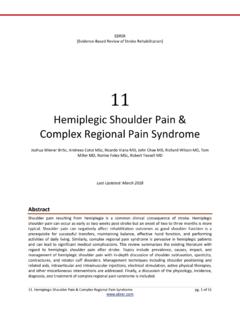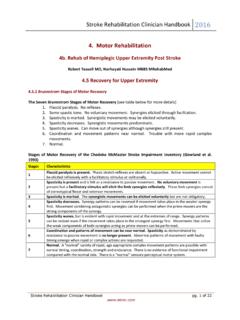Transcription of Outcome Measures in Stroke - EBRSR
1 20. Outcome Measures in Stroke Rehabilitation pg. 1 of 141 EBRSR [Evidence-Based Review of Stroke Rehabilitation] 20 Outcome Measures in Stroke Rehabilitation Katherine Salter PhD (cand.), Nerissa Campbell PhD, Marina Richardson MSc, Swati Mehta PhD (cand.), Jeffrey Jutai PhD, Laura Zettler MSc, Matthew Moses BA, Andrew McClure MSc, Rachel Mays BSc (cand.), Norine Foley MSc, Robert Teasell MD Last Updated: september 2013 Abstract To enhance the clinical meaningfulness of the SREBR, the present review provides the best available information on how Outcome Measures might be classified and selected for use, based upon their measurement qualities.
2 For this purpose, we have selected for review some of the most commonly-used Measures in Stroke rehabilitation. The ICF conceptual framework is used to classify Measures in Stroke rehabilitation and aspects of measurement theory pertinent for evaluating Measures are discussed. Each measure reviewed in this chapter was evaluated in terms of appropriateness, reliability, validity, responsiveness, precision, interpretability, applicability and feasibility. All Measures were assessed for the thoroughness with which its reliability, validity and responsiveness have been reported. The present document contains summary reviews of 38 assessment tools used in the evaluation of Body Structure (14 tools), Activity (15 tools) and Participation (9 tools) outcomes.
3 20. Outcome Measures in Stroke Rehabilitation pg. 2 of 141 Table of Contents Abstract .. 1 Table of 2 4 Domains of Stroke Evaluation Criteria for Outcome Has the Measure Been Used in a Stroke Population? ..8 Has the Measure Been Tested for Use with Proxy Assessment? ..8 What is the Recommended Timeframe for Measurement? ..9 Body Structure/Impairment Outcome Measures .. 9 Beck Depression Inventory (BDI) .. 10 Behavioral Inattention Test (BIT) .. 11 Canadian Neurological Scale (CNS) .. 15 Clock Drawing Test (CDT) .. 16 Frenchay Aphasia Screening Test (FAST) .. 18 Fugl-Meyer Assessment of Motor Recovery after Stroke (FMA) .. 20 General Health Questionnaire 28 (GHQ-28).
4 22 Geriatric Depression Scale (GDS) .. 24 Hospital Anxiety and Depression Scale (HADS) .. 26 Line Bisection Test (LBT) .. 28 Mini-Mental State Examination (MMSE) .. 29 Modified Ashworth Scale (MAS) .. 31 Montreal Cognitive Assessment (MoCA) .. 33 Motor-free Visual Perception Test (MVPT) .. 35 National Institutes of Health Stroke Scale (NIHSS) .. 36 Orpington Prognostic Scale (OPS).. 38 Stroke Rehabilitation Assessment of Movement (STREAM) .. 40 Activity/Disability Outcome Measures .. 42 Action Research Arm Test (ARAT) .. 42 Barthel Index (BI) .. 43 Berg Balance Scale (BBS) .. 46 Box and Block Test (BBT) .. 48 Chedoke-McMaster Stroke Assessment Scale (CMSA).
5 49 Chedoke Arm and Hand Activity Inventory (CAHAI).. 50 Clinical Outcome Variables (COVS) .. 52 Functional Ambulation Categories (FAC) .. 53 Functional Independence Measure (FIM).. 54 Barthel Index vs. the Functional Independence Measure .. 56 CIHI - National Rehabilitation Reporting System .. 57 Frenchay Activities Index (FAI) .. 57 Modified Rankin Handicap Scale (MRS) .. 60 Motor Assessment Scale (MAS) .. 62 Nine-hole Peg Test (NHPT) .. 64 Rivermead Mobility Index (RMI) .. 66 Rivermead Motor Assessment (RMA).. 67 Six-Minute Walk Test (6 MWT) .. 68 20. Outcome Measures in Stroke Rehabilitation pg. 3 of 141 Timed Up & Go Test (TUG).
6 71 Wolf Motor Function Test .. 73 Participation/Handicap Outcome 76 Canadian Occupational Performance Measure (COPM) .. 76 EuroQol Quality of Life Scale (EQ5D) .. 79 LIFE-H (Assessment of Life Habits) .. 81 London Handicap Scale (LHS) .. 83 Medical Outcomes Study Short Form 36 (SF-36) .. 85 Nottingham Health Profile (NHP) .. 87 Reintegration to Normal Living Index (RNLI) .. 89 Stroke -Adapted Sickness Impact Profile (SA-SIP-30).. 91 Stroke Impact Scale (SIS) .. 93 Stroke Specific Quality of Life Scale (SSQOL) .. 94 Conclusions and Recommendations .. 95 Evaluation Summaries by ICF Category .. 96 References .. 100 20. Outcome Measures in Stroke Rehabilitation pg.
7 4 of 141 Introduction Measuring the effectiveness of interventions is accepted as being central to good practice. Van der Putten et al. (1999) pointed out that measuring the Outcome of health care is a central component of determining therapeutic effectiveness and, therefore, the provision of evidence-based healthcare, (van der Putten et al. 1999). The Stroke Rehabilitation Evidence-Based Review (SREBR) is a landmark achievement in consolidating the best-available scientific evidence for the effectiveness of Stroke rehabilitation. But, there are limitations to successfully transferring the research results to clinical practice and service delivery.
8 Some are imposed by the current state of Outcome measurement in Stroke rehabilitation. Limitations include the lack of consensus on the selection of Measures to best address and balance the needs and values of stakeholders in Stroke rehabilitation, including patients and their caregivers, practitioners, and health care decision makers. Ultimately, the comparison of size and direction of statistical results across areas of Stroke rehabilitation covered within the SREBR will be most meaningfully interpreted when it is clear that comparable approaches to Outcome measurement have been used (Jutai & Teasell 2003). To enhance the clinical meaningfulness of the SREBR, we present the best available information on how Outcome Measures might be classified and selected for use, based upon their measurement qualities.
9 For this purpose, we have selected for review only some of the more commonly used Measures in Stroke rehabilitation. We do not intend this to be a comprehensive compendium of Stroke Outcome Measures . In this chapter, we attempt to describe how the ICF (WHO 2001, 2002) conceptual framework can be used for classifying Outcome Measures in Stroke rehabilitation, and summarize aspects of measurement theory that are pertinent for evaluating Measures . We also give a template presentation on the characteristics, application, reliability, validity, and other clinimetric qualities of commonly used Measures in a format for easy reference.
10 For a more extensive discussion of Outcome measurement theory and properties in rehabilitation, we refer the reader to the book authored by Finch et al. (2002). This chapter will present only the information most relevant for Stroke rehabilitation. Domains of Stroke Rehabilitation Outcomes research requires a systematic approach to describing outcomes and classifying them meaningfully. The study and assessment of Stroke rehabilitation has sparked the development of numerous Outcome Measures applicable to one or more of its many dimensions. In attempting to discuss some of the commonly used Measures available for use within the field of Stroke rehabilitation, it is useful to have guidelines available for classifying these tools.






